Vlach-speaking Vocal Music in the Western Balkans: An Introductory Note
Vlach speaking vocal music participates in the wider context of the musical tradition of the Pindus mountain range in Western Greece and generally in the musical context of Western Greece (Epirus, Western Macedonia, Western Thessaly, and mountainous Roumeli) and Southern Albania (Northern Epirus). What will be presented here is a brief note of the results of research conducted by the writer in the years 1990- 2010.
These musical characteristics are part of the music of Epirus (the southern part is in today’s Greek territory, while the northern part is in today’s Albania) and do not appear beyond Epirus in today’s northern Albania. This enables us to refer to a musical language which is developed and divided into distinct musical dialects, and extending through four languages (Greek, Vlach, Albanian, and Slavic) in such a way as to present itself as an extremely ancient native musical language in the area.
The archaism of this musical language classifies it among the older and most important in the Balkans (together with the other distinct vocal repertory of Central Serbia and Bosnia-Herzegovina). Among its special characteristics, one can underline its flexibility to apply itself to different languages, its numerous variations regarding tonal groups, and its variable polyphonic and heterophonic styles which from area to area are subjected to a general formation of local musical idioms which suggest a extremely ancient common starting point and at the same time a simultaneous evolution over the centuries which resulted in a geographically distributed final formation of several musical idioms which in their turn are nonetheless part of one and the same musical language.
The central idiom of this language is considered to be the idiom of Northern Pindus in Greece together with the central mountainous area of Northern Epirus. In the case of the Pindus mountain range, one can refer to a unified tradition almost without inner cracks in the different ritual songs, though it uses two different languages (Vlach and Greek) in the Vlach villages of Pindus. Studying the ritual songs one can attest the use of one and the same musical idiom in the two languages.
The tonal groups in this musical idiom are constituted of two basic types of pentatonic tuning: hemitonic pentatonic (la-sib-re-mi) with a enharmonic slide around the area of the semitone (la-sib), and anhemitonic pentatonic (la-do-re-mi). We had many references to the second type but no reference to the first type, which was not attested in the area of Epirus. It was attested for the first time in 1998 by the writer (see Katsanevaki 1998) and it presents a good reason for the slides observed by previous writers (among others George Marcu) who always put a question mark on the reason for these slides appearing, as they are not similar to slides found in other musical idioms in the world. Though it seems to refer to an extremely remote time we should mention that what happens in the music of Pindus is attested and explained by ancient Greek writers and especially by Pseudoplutarch in his work “On Music”.
There are many reasons for these songs to be so important: One of them is the possibility to comprehend and to interpret the ways the heptachord system was created in antiquity. Much of this contribution can be attributed to the Farseriot repertory which as it was recorded in Argyropouli (Karadzoli) in Larisa (Thessaly-Greece) presents a hexachord system. Such a system seems to be a preliminary stage for the heptachord system of the Northern Pindus and a large part of Epirus. This hexachord system (mi-sol-sib-do) can be traced in some of the songs of the Çam people as well as a succession of minor thirds (mi-sol, sol-sib) can be traced in Southern Pindus as well in the Greek-speaking repertory of the nomadic Sarakatsans and the rest of the Greek-speaking villagers of the area. The tonal groups are many and various though tightly bound to each other.
The heterophonic style of Pindus shared by Vlach-speakers and Greek-speakers can use up to 3-4 voices-melodies. The Vlach polyphonic style in Northern Epirus uses three voices coming one after the other as an imitation. This is called an “imitation” polyphonic style and is also shared by the male repertory of the Çam people. Usually among the Vlach people of Northern Epirus, women sing in the same way using some small variations in the way they sing the different melodies. So among the Vlach speakers the male and the female repertory follows more or less the same structure.
It is important to confirm here the existence of a similar system among the Slavic-speaking (“native” as they call themselves) Macedonians in western Macedonia in Greece together with similar forms of the lament melodies. This confirms a strong link and an old root in the area, for the vast percentage of the Vlach speakers and Slav speakers of the area together with the Greek-speaking Epirots and Macedonians in Western Greece, as well as with the Albanian speakers of the wider area of Northern Epirus in today’s Southern Albania.
Musical Examples
An example of anhemitonic pentatonic structure (sol-la-do-re) in a female ritual dance, a Greek-speaking song from Fourka (Vlach village in Konitsa region) (Tora to Vradi- vradaki “Now that the night comes”) (Katsanevaki 1998, Part II, ex.3):
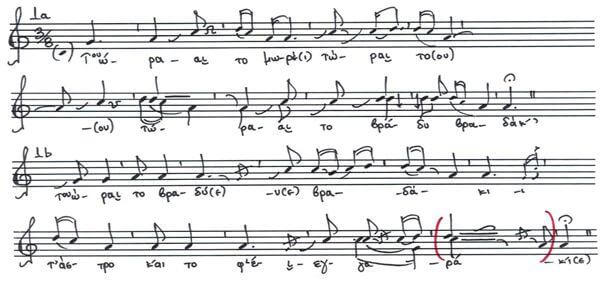
An example of hemitonic pentatonic structure (la-si-do-mi) in a female Vlach-speaking lament from Samarina (Grevena region), Vini uara uara l΄i (“Now that the great moment has come”) (Katsanevaki 1998, Part II,ex.59):
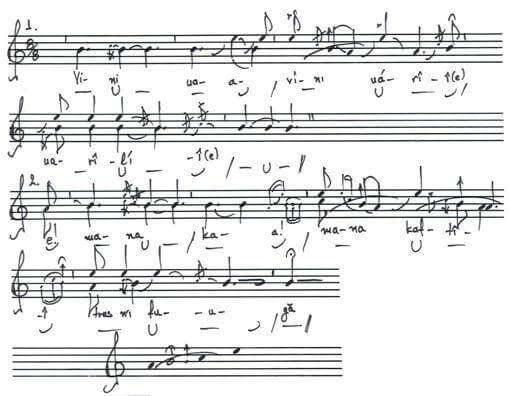
The “tachtarisma,” a billigual children’s song in Greek and Vlach from Armata (Konitsa region):
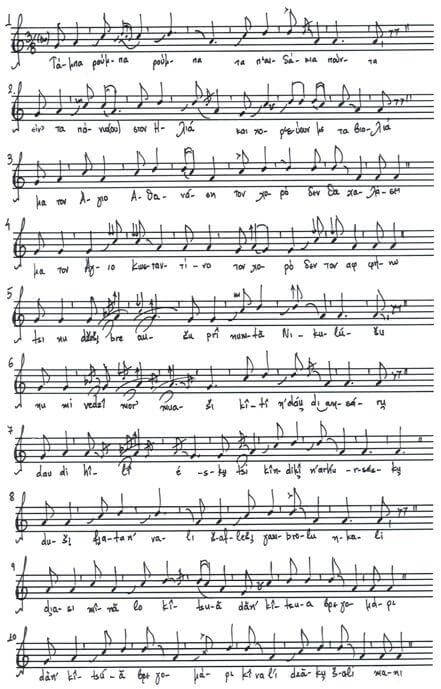
Part of a Farseriot polyphonic song from Argyropouli (Karatzoli) “Dzįubleį mušįatî trįatsî di la uboru” (Katsanevaki 1998,Part II ex.115):
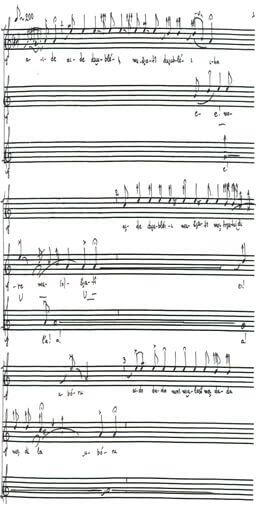
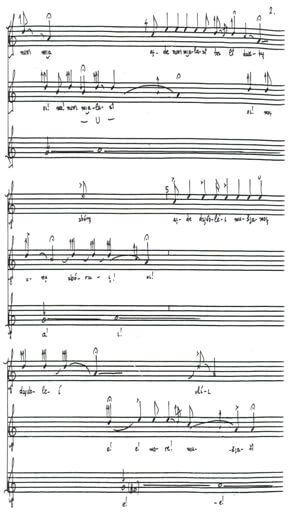
Sources
– Αριστοτέλης
Προβλήματα Βιβλίο ΙΘ (ΧΙΧ) “Οσα περι Αρμονία” Book XIX, Books I-XXI The Loeb Classical Library Harvard University Press, 1961. Great Britain.
– Πλούταρχος
Πλουτάρχου Περι Μουσικής.
Plutarch. Uber die Musik, von Rudolf Westphal, Breslau, 1865.
Plutarch’s. On Music. The Loeb Classical Library. Plutarch’s Moralia XIV Harvard University Press, 1967.
Selected Bibliography
– Elshekova Alica
1981:Vergleichende typologische Analysen der vokalen Mehrstimmigkeit in der Karpaten und auf dem Balkan. Stratigraphische Probleme der Volksmusik in der Karpaten und auf dem Balkan. Editor A.Elschekova. Verlag der Slovakischen Akademie der Wissenschaften. Bratislava, 1981 σελ. 159-256.
– – Demo Ondrej
1981: Slowakische dialogische Gesange (Antiphonalformen) aus den Norawestkarpaten. Bratislava. Stratigraphische Probleme der Volksmusik in den Karpaten und auf dem Balkan. A.Elschekova Veda. Verlag der Slovakischen Akademie der Wissenschaften Bratislava, 1981 σελ.141-153.
– Georgescu Dan Corneliu
1981: Das “Haulit” im subkarpatischen Oltenien. Bukarest. Stratigraphische Probleme der Volksmusik in den Karpathen und auf dem Balkan. A. Elschekova Veda. Verlag der slovakischen Akademie der Wissenschaften Bratislava, 1981 σελ.115-131.
– Katsanevaki Athena
1998: Vlach-speaking and Greek-speaking songs from Northern Pindus. A Historical -Ethnomusoclological Approach: Their Archaism and their relationship with the Historical backround. Phd Dissertation, Aristotle University of Thessaloniki, Part I&II, 3 Volumes, 7 tapes, Thessaloniki,1998 (In Greek).
– Kruta Beniamin
1985: Elements musicaux convergents et divergents entre l’epopee albanaise et celle sud- Slave.
Culture populaire Albanaise V 1985 σελ.103-121.
– Λεωτσάκος Γιώργος
1985: Αλβανική Μουσική ή ένα λείμμα εγκυκλοπαίδειας που έμεινε αδημοσίευτο. Μουσικολογία 185 Ετος 1, Τεύχος 1, σελ.23-55.
– Λώλης Κώστας
1995: Το πολυφωνικό τραγούδι στην νότιο Αλβανία. Ανακοίνωση στο Α Διαβαλκανικό Φεστιβάλ. Θεσσαλονίκη.
– Marcu George
1958: Cintecele poliphonique aromane. Revista de folklor III 1958. Bucuresti σελ.79-99.
1977: Folklor Muzical Aroman. Editura Muzicala – Bucuresti.
– Stockmann Doris – Stockmann Erich – Wilfried Fiedler
1965: Albanische Volkmusik I Gerange der Camen Akademie – Verlag – Berlin.
– Περιστέρης Σπυρίδων
1958: Δημοτικά τραγούδια Δροπόλεως Βορείου Ηπείρου. Ακαδημία Αθηνών Επετηρίς του Λαογραφικού Αρχείου Τομ. 9-10 1955-7 εν Αθήναις, 1958 σελ.105-133.
– – Pistrick Eckehard
2005: Lab Epic and Historic Songs in the Saranda Region (South Albania) – Continuity and Change in an Oral Tradition. Magisterarbeit. Martin – Luther Universität Halle –Wittenberg Fachbereich Musik –Sport-und Sprechwissenschaft, Institut für Musikwissenschaft, Halle 2005.
– Sokoli Ramadan
1965: Folkori Muzikor Shqiptar. (Morfologjia) Instituti i Folklorit Tirane.
– Τέντα Γεωργία
1995: Δημοτικά τραγούδια Πολύτσανης Βορείου Ηπείρου. Διπλωματική εργασία ΑΠΘ Θεσσαλονίκη.
– West, M.L.
1992: Ancient Greek Music. Clarendon Press – Oxford.
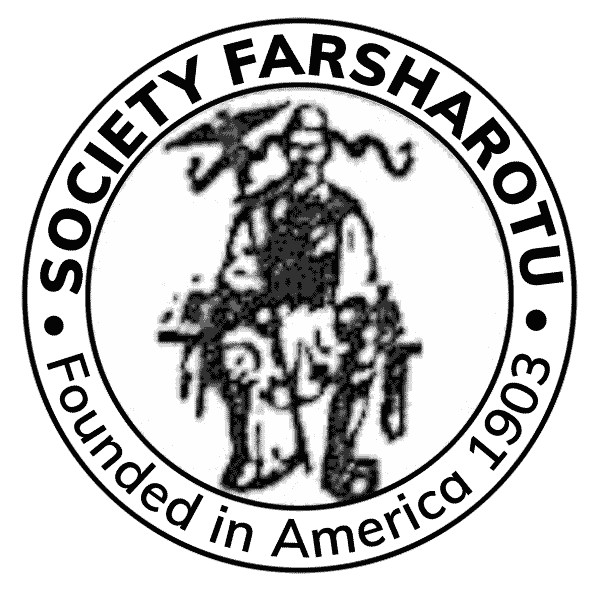
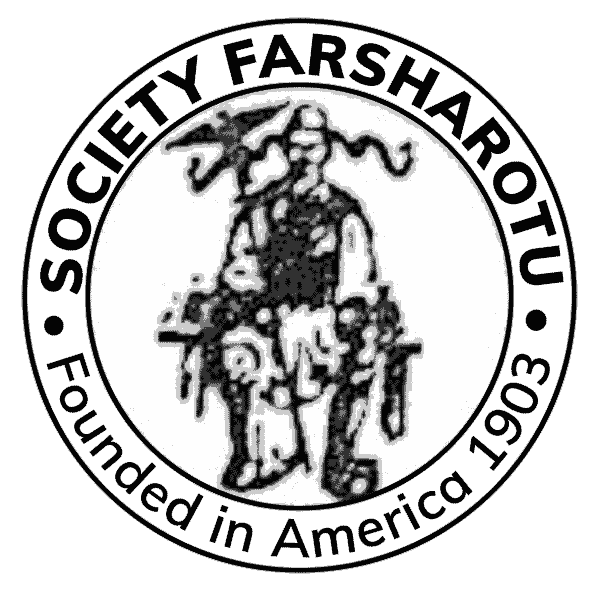
Responses